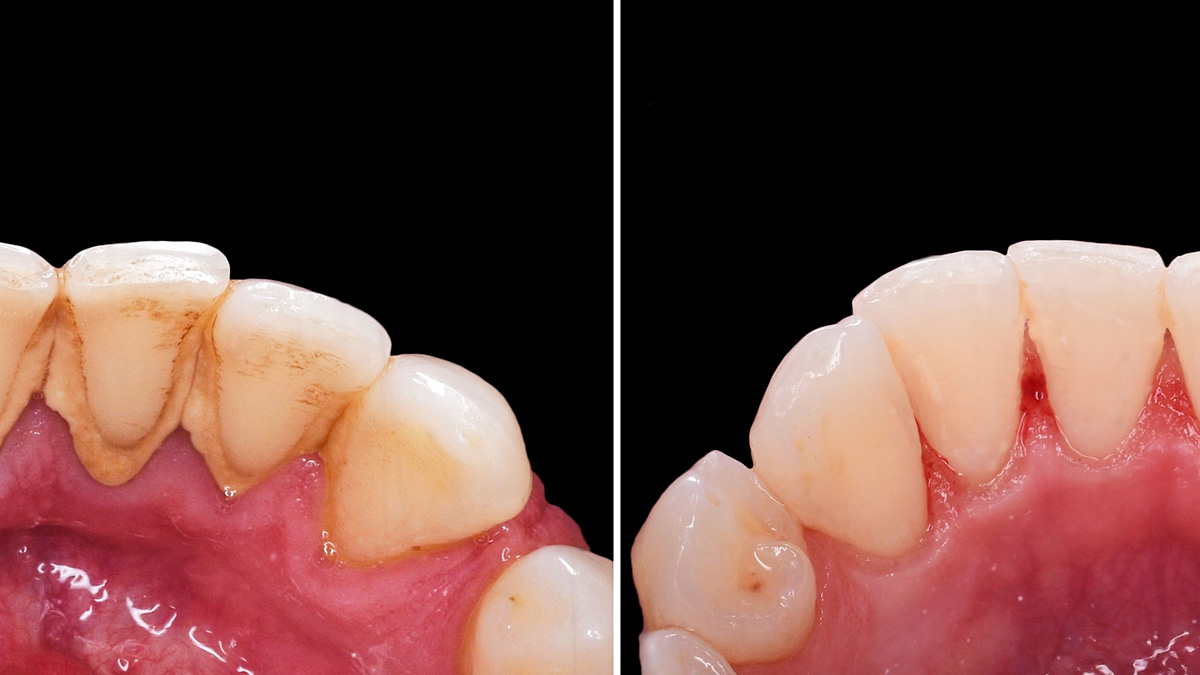Polishing and sandblasting teeth – Complete service for your smile
What is dental calculus and how does it form?
Dental calculus is a hard deposit that forms through the mineralization of dental plaque. If plaque is not removed with regular brushing and flossing, it eventually turns into calculus. Calculus can contribute to gum disease and cavities, so its regular removal is crucial for oral health.
Causes of dental calculus
The main cause of dental calculus formation is insufficient removal of plaque from the mouth. A diet high in sugars and starches, as well as smoking, can further contribute to its formation. Regular professional cleanings and proper oral hygiene can help in prevention.
What is tooth sandblasting?
Tooth sandblasting, also known as air-polishing, is a modern deep cleaning procedure used to remove dental calculus, plaque, and stubborn surface stains that cannot be removed by standard brushing or polishing. During this procedure, a specialized device uses a jet of water, air, and fine powder abrasive to gently yet thoroughly clean the tooth surfaces, interdental spaces, and areas around the gums. Sandblasting is particularly useful for removing deposits and stains from coffee, tea, tobacco, or red wine. In addition to improving the aesthetics of the smile, sandblasting also promotes gum health by reducing deposits that can lead to gingivitis and periodontitis.
Tooth sandblasting procedure
The tooth sandblasting procedure includes the following steps:
- Preparation for tooth sandblasting: As with polishing, the dentist or dental hygienist will first examine the teeth and gums to assess the patient’s condition and needs.
- Protection of oral tissues: Various protective materials, such as rubber sealing shields, may be used to protect the soft tissues in the mouth.
- Tooth sandblasting: A specialized sandblasting device is used to blow fine abrasive powder onto the tooth surfaces under controlled pressure. This mixture effectively removes plaque, calculus, and surface stains without damaging the tooth enamel.
- Mouth rinsing: After sandblasting, the mouth is carefully rinsed to remove all remaining abrasive particles and ensure complete cleanliness.
- Post-sandblasting review and consultation: The dentist or dental hygienist will examine the teeth after the procedure and may provide additional oral hygiene advice or recommend further treatments if necessary.
What is tooth polishing?
Tooth polishing is a procedure that completes a professional teeth cleaning. After removing dental calculus and plaque, the teeth are polished with a special paste. This paste is mildly abrasive and is used together with a rotating brush or rubber cup. Tooth polishing removes surface stains, makes the tooth surface smooth and shiny, and helps prevent subsequent plaque buildup due to the smooth surface it creates. In addition to aesthetic improvements, polishing contributes to oral health by reducing surfaces where bacteria can accumulate.
Tooth polishing procedure
The steps of tooth polishing are as follows:
- Preparation for tooth polishing: Before polishing, the dental hygienist or dentist will thoroughly examine the patient’s oral health to identify areas that require special attention.
- Removal of dental calculus: Although polishing itself does not remove dental calculus, it is important that the calculus is already removed before polishing begins. This is usually achieved using ultrasonic instruments.
- Polishing: A special rotating brush or rubber attachment with mildly abrasive paste is used. The dental hygienist carefully polishes each tooth, removing surface stains and smoothing the tooth surface to make it smooth. A smooth surface makes it harder for new plaque to accumulate.
- Mouth rinsing: After polishing, the mouth is carefully rinsed to remove all remaining paste and ensure cleanliness.
- Fluoride treatment (optional): Sometimes, after polishing, a fluoride treatment may be applied to further strengthen the tooth enamel and prevent cavities.
Difference between tooth polishing and whitening
Tooth polishing focuses on removing surface deposits and smoothing the teeth, while whitening uses chemical agents to achieve whiter teeth. Both procedures improve the appearance of the smile, but they address different aspects.
Everything you need to know about tooth polishing and sandblasting
Tooth polishing and sandblasting are procedures recommended every 6 to 12 months, depending on individual needs and your dentist’s recommendations. These procedures are safe for most people, but it is important to have an examination first to ensure there are no contraindications. The frequency of visits may vary depending on your oral habits and overall dental health.
Scheduling an appointment for tooth polishing and sandblasting
Scheduling your appointment for tooth polishing and sandblasting with us is quick and easy. You can contact us by phone, email, or through our website. During your visit, our experts will conduct a detailed examination and consultation to ensure you receive the best possible care tailored to your needs.


